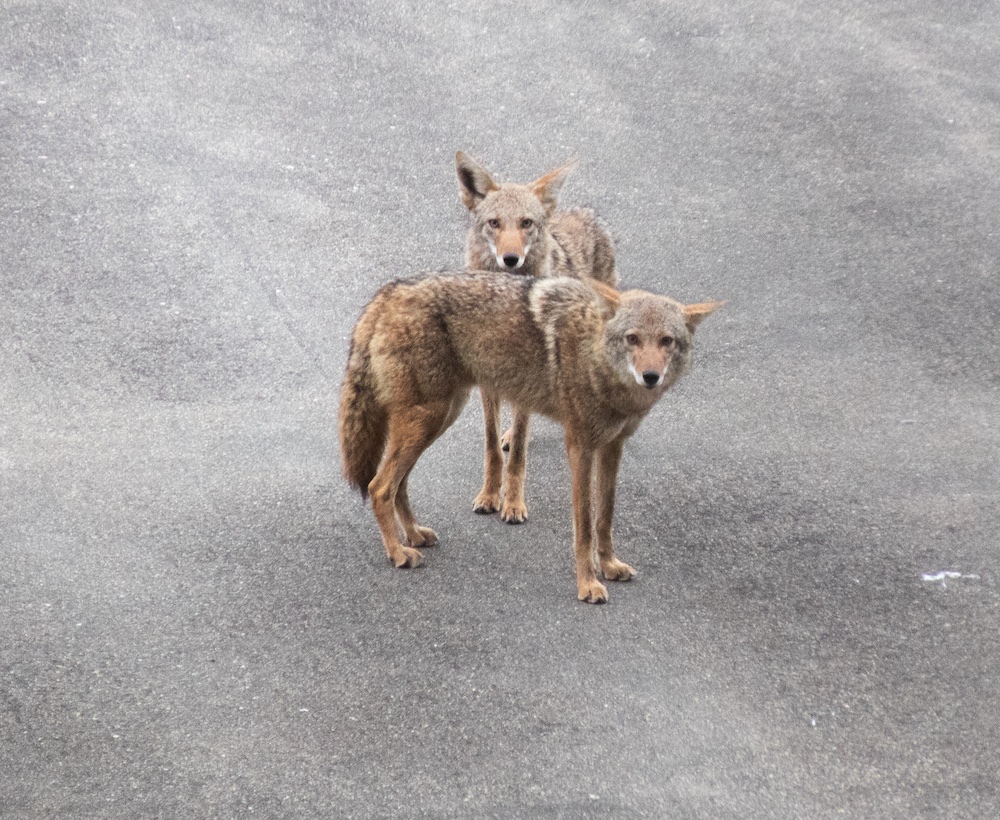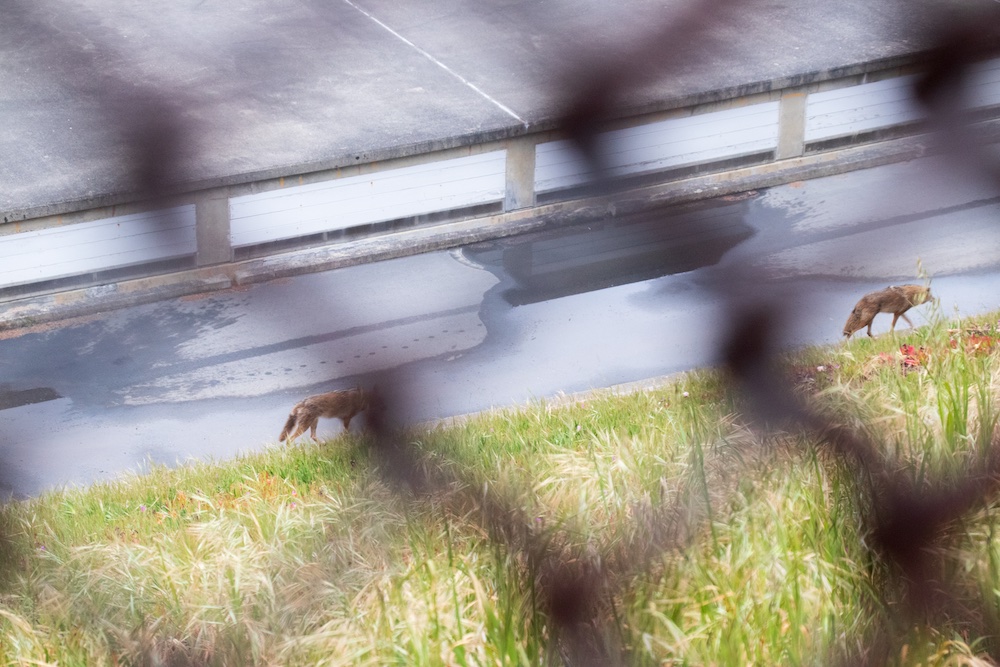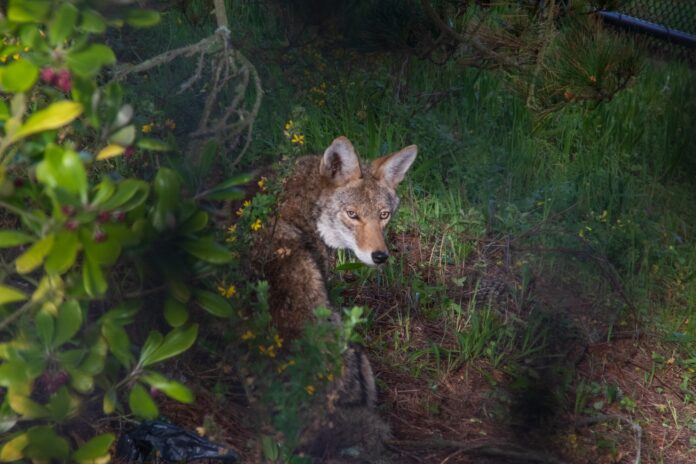When the sun obliges, the view from the south end of Sunset Reservoir on 26th Avenue and Quintara offers a particularly American sparkle. The blue Pacific gleams to the west, the Golden Gate Bridge glows red to the north, and over San Francisco’s largest reservoir glitters, white-hot, a solar field of 24,000 photovoltaic panels.
On a recent Saturday, though, a small blur smudged Old Glory. And then the smudge moved, trotting with a lope that most San Franciscans have come to recognize.
In yet another feat of amazing urban adaptation for this animal, a pair of coyotes have chosen to den on an 11-acre concrete waterbed, tucked under five annual megawatts’ worth of crackling solar energy in the heart of San Francisco’s Sunset District. Depending on whom you ask, their presence is to be feared, ignored, respected, or celebrated.
*********
“We had a knee-jerk reaction at first,” Misti Sporer, Lead Environmental Scientist at Duke Energy Renewables, which controls the project, said by phone from North Carolina about learning in 2018 that a 25-35 pound Canis Latrans (“barking dog”) used their solar panels as tanning beds by day. “But we talked it out as a team.”
That may be fine for a corporation on the other side of the country, but what about the parade of dog walkers that enjoy the paved trail around Sunset Reservoir?
Dan Flores, author of Coyote America, has been awed by the carnivores since witnessing them in the Louisiana bayous of his childhood. (“It was like turning a corner on Bourbon Street and seeing a moose.”) He hopes San Franciscans can take the long view.
“My advice to dog walkers is to learn about the rhythms of coyote life,” Flores said. “Except for the occasional maverick (and coyotes are very individualistic), coyotes will look at dogs but not bother them most of the year.”
Help us save local journalism!
Every tax-deductible donation helps us grow to cover the issues that mean the most to our community. Become a 48 Hills Hero and support the only daily progressive news source in the Bay Area.
Spring pupping season is the exception, which Deb Campbell of San Francisco Animal Care and Control wants dog walkers to recognize.
“Coyotes will exhibit protective behavior if there is a den in the area,” Campbell says. “They may follow dogs, bare their teeth, snarl, nip at a dogs rear end/legs. This is coyote-speak for ‘move along!’—not aggression. The coyotes aren’t stalking or hunting people, which is what many assume.”

Camilla Fox of Project Coyote in Larkspur hopes Earth Day 2021 can inspire San Franciscans past mere tolerance to sheer celebration.
“The presence of coyotes in urban landscapes lets us think what it means to coexist with our wild neighbors,” Fox said. “And one coyote eats up to 1800 rodents a year, free rodent control so we don’t have to use deadly rodenticide that causes harm to our shared environment.”
Duke Energy’s Sporer can vouch for the rodent-control.
“We have a free extermination force on site,” Sporer said. “Rodents will chew through the coating of wires, shredding up material for burrows.” Sporer said a few workers onsite have noticed less wire damage since the coyotes moved in.
Although coyotes have their champions, scroll through most any Nextdoor chat in the Bay Area and try not to find a terrified screed against the carnivores. As opportunistic as humans (one reason many Native American oral traditions starred “the trickster”), coyotes will occasionally prey on feral cats and small dogs off leash or left outside.
That’s not in question. On this Earth Day, however, the question is whether we want to shift the heavy habits of our dominant species—nearing 8 billion—to help accommodate the presence of another species.
Aside from imploring the public not to feed coyotes (“We investigated a case of people dumping 20 pounds of cooked meat by Lake Merced every day”), Campbell shares the truth about trapping wild animals in California.
“Wild animals that have been trapped must be killed,” Campbell says. “Not many people realize that the trapper hired to remove a skunk from their yard will legally have to kill the animal. They are not taking it to a skunk sanctuary.”
For those who still insist on removal or eradication, Flores says, read your history. It’s been tried before.
“The truth is the United States, in the last 150 years or so, has engaged in the largest mass destruction of wildlife discoverable anywhere in world history,” Flores said. “All our attempts to eradicate coyotes or control their numbers have backfired.”
One of the adaptations that make coyotes so resilient, and one more trait they share with humans, is the biological capacity of fission-fusion adaptation.
In short, when the US Eradication Methods Laboratory used blanket poisoning from 1947 to 1956 to kill 6.5 million coyotes, the survivors fissured out as individuals to other parts of the country, until they were able to fuse back into pairs and mate. According to Flores, the extermination campaign “produced modern coyote Manifest Destiny and spread them in every direction.”
“We’re going to have to learn to live with coyotes. Resistance is basically futile.”
************
The tricksters, of course, were nowhere to be seen when the reporter returned a few days later with Nikon binoculars.
Dog walkers circling the den were well aware of the coyotes, more eager to share their stories than their names. A 20-something woman in an electric pink puffy jacket and her small terrier off leash brushes off the coyotes. “Sometimes they dig through my trash. I don’t walk him at night.”
A tall man in a straw hat with an easy smile walking a Tibetan mastiff points to the small space under an entrance gate to the reservoir on 28th Avenue and Pacheco. “That’s the hotspot.” And a PUC gardener leaning on his shovel on a break from tending a bed chuckles at how he’ll find his dug-up gopher traps licked clean.

“We’ve definitely seen a lot more coyotes in the Sunset over the last couple of years,” Chris Duncan, a neighborhood resident, shared for the record. “The kids saw one, pre-COVID, on their walk to school and thought it was a fox. ‘Umm, no, definitely a coyote, guys.’”
“They’re wild animals, so people should be aware, keep their distance, have dogs on leash and eye out if your kids are playing near the reservoir.”
Duncan has the attitude that Jonathan Young, Wildlife Ecologist at the Presidio, hopes more San Franciscans can adopt to honor Earth Day—especially newbie owners with pandemic puppies.
“We were all sequestered for so long due to the pandemic, and now we’ve come to understand and value open space and access to open spaces even more,” Young said. “And there are things people do that affect these natural urban areas for better or worse. Our behavior drives or reduces the conflict with coyotes.”
************
Thirty minutes of staring at bright, coyote-less solar panels through binoculars produces a dull headache, so a walk is in order. Along the way, a young man in a blue windbreaker with a sweet terrier on leash breaks up the coyote obsessed line of questions with “I don’t know if you care about other wildlife. Lots of other stuff here.”
Good point. One could do worse for an Earth Day celebration than circle the Sunset Reservoir. Walking counter clockwise from the red, white and blue height at the reservoir’s south end, the three-quarter mile path heads downhill next to a neat line of native plants including Sticky Monkey bursting with yellow flowers, a big row of cistus bushes with pink cups, and a crawling green ceonothus showing off blue blossoms.
Anna’s hummingbirds weave in between for nectar, and a troop of raccoons scramble up a Monterrey pine, their bandit eyes warily peering through the 15-foot black fence. A redtail hawk rises on a thermal uplift until its wings disappear into the sun.
The coyote has returned by the end of the loop, curled up on a solar panel to weather the Pacific breeze grown stiffer in the afternoon. Hard to tell which of the pair it is, but if the experts’ hunch of a den is true, a litter could be just under the panel.
“After they give birth, it’s about seven weeks before pups are big enough to stick their heads out and go hunt for food,” Fox said. “Parents will go out and eat rodents, rabbits, insects. Pups will lick their parents’ lips on the return, and parents will regurgitate the meal.”

And where there is a meal, there is scat. Although the coyotes seem to avoid sullying their warm beds, it’s a different story underneath on the reservoir.
“We are actually working with Janet Kessler, a local naturalist who has been studying San Francisco coyotes for nearly 15 years,” Will Reisman, Press Secretary for the San Francisco Public Utilities Commission, says. Kessler is sending the scat to UC Davis for DNA analysis to confirm her own findings on urban coyotes.
Forty-five minutes of non-stop glassing reveals a few stretches, yawns, counter curls. Nothing comes near the coyote besides two juvenile crows making a few close passes that get an ear twitch or two. Other than that, a peaceful, warm nap on a solar bed. The value of the location, location, location of their den is becoming apparent.
“They have a nice buffer there,” Young say. “It’s good for everyone. The chances of conflict go way down.”
*************
The reservoir, solar panels and coyotes offer some lessons in conservation. For example, it would take God knows how many more Sunset Reservoirs for complete water security as California faces down another drought. And most of the treacherous high electricity wires that crisscross our state like waiting fuses need to be replaced with a blanket of solar panels to reduce the chances of catastrophic fires ASAP.
Throw in a pandemic that knocked humanity ass-backwards, shutting down trillion dollar economies as easily as an iceberg nicking the Titanic, and one could wonder what will ever inspire humanity to help restore—and rejoin—the balance of nature once more.
We can’t completely trust the coyote; no one wants their small dogs or cats to become a meal. To say coyotes are our friends is to say nature is our friend. Riptides on Ocean Beach, fault lines under our feet, and a global pandemic have taught us otherwise.
But we still surf and hike and carry on. And while we may think we have the capacity to eliminate or harness everything in nature that we deem not friendly, the Earth might not offer enough vaccine for us to survive what we create.
A coyote sitting on a solar panel on a reservoir seems to offer a different path. We can go one direction or the other. Either way for the coyote. They can go it alone.
“I think that’s the point I’d make about coyotes and Earth Day,” Flores said. “Coyotes remind us of how old a place America is. We think of the United States as a new nation, and to a degree it is. But America is a very, very ancient continent. Its human story goes back at least 15,000 years, and its coyote story a million years.”
“That’s why, when I listen to coyotes’ yips and howls, I always think I’m getting to hear the continent’s original national anthem.”





